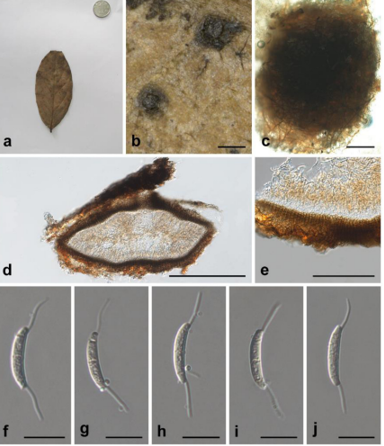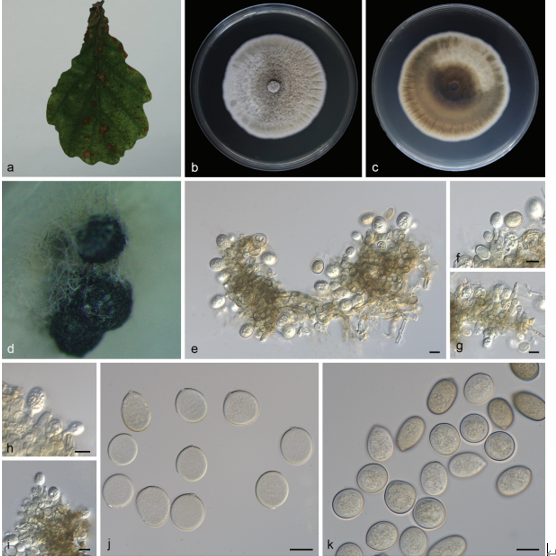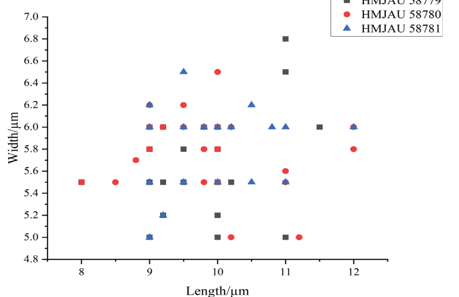Cantharellus aurantinus Ming Zhang, Z.H. Zhang & T.H. Li sp. Nov.2021
MycoBank: MB840837.
Type—CHINA. Henan Province, Xinyang City, Nanwan Lake Scenic Area, 420 m, N 32 110 ,E113◦960 , on soil in Castanopsis spp. dominated forests, 18 July 2016, Ming Zhang (GDGM46278)
Sexual morph: Basidiomata small-sized. Pileus 15–40 mm broad, convex when young, then gradually to nearly applanate with a central shallow depression at maturity; surface dry, smooth, light yellow, light orange, greyish yellow to greyish orange (2A5–6A5, 2B5–6B5), margin even, incurved when young, decurved to slightly upturned at maturity, unchanging when handled. Context white to yellowish white, 1.5–2.5 mm thick in the center of the pileus, sharply attenuate towards margin, unchanging when exposed. Hymenophore decurrent, relatively well developed, composed of bifurcate and interconnected low veins, in particular toward the cap margin, usually less than 1 mm high, pale yellow (2A3–4A3), unchanging when bruised. Stipe 20–40 × 8–12 mm, central, cylindrical or slightly tapering towards base, solid, smooth or with faintly scaly, pale yellow to pale orange (2A3–5A3), unchanging when handled. Odour not distinct.
Basidiospores (100/4/4) (6.5–)7–9 × (4.5–)5–6 µm, Lm × Wm = 7.95(±0.57) × 5.51(±0.42) µm, Q = (1.16)1.3–1.6(1.7), Qm = 1.45±0.13, broadly ellipsoid, smooth, guttulate. Basidia 48–70 × 8–10 µm, 4–6-spored, narrowly clavate, colourless to hyaline in KOH; sterigmata 3–8 µm long. Pileipellis a cutis with long, repent and occasionally interwoven hyphae, subcylindrical cells that are 5–10 µm wide, thin-walled, obtusely rounded at the top. Stipitipellis a cutis of cylindrical, parallel hyphae, 3–12 µm wide. Clamp connections abundant in all tissues.
Habitat: Growing in solitary or scattered under Fagaceae trees that are mixed with other broadleaf trees in subtropical broadleaf forests
Distribution: . Known from Henan and Jiangsu Province, China
GenBank Accession: GDGM46278 China lsu MZ766517;tef1 MZ766560. GDGM46279 China lsu MZ766518;tef1 MZ766561;rpb2 MZ766571. GDGM84974 China lsu MZ766521;tef1 MZ766564;rpb2 MZ766572. GDGM84978 China lsu MZ766522;tef1 MZ766565. GDGM81889 China lsu MZ766519;tef1 MZ766562;rpb2 MZ766574. GDGM81899 China lsu MZ766520 ;tef1 MZ766563;rpb2 MZ766573.
Notes:The distinctive morphological features of C. aurantinus are the light orange to greyish-orange pileus, the pale yellow, gill-like folds with bifurcate and interconnected low veins, the broadly ellipsoid basidiospore, and the thin-walled hyphae of the pileipellis. The phylogenetic analyses supported C. aurantinus as an isolated lineage (Lineage VII) that is closely related to C. curvatus and C. himalayensis. However, C. curvatus, recently reported from South Korea, differs by its small and slender basidiomata, dull yellow to orangish[1]yellow pileus, and shorter basidia (42–55 × 9.5–12 µm) [33]. Cantharellus himalayensis, that is reported from India, differs by its large basidiomata, yellowish pileus with pecan-brown scales at the center, relatively small basidiospores (6–8 × 4.5–6 µm), and partially gelatinous pileipellis [38]. In the field, C. aurantinus is easily misidentified as C. cibarius, as both species share a yellow-orange pileus. However, C. cibarius belongs to the subg. Cantharellus, and differs by its relatively large basidiomata, well-developed hymenophore of up to 3 mm in depth, longer basidia (80–105 × 7–9 µm) and thick-walled pileipellis hyphae [9,18].
Reference:[1] Zhang, M. , Wang, C. Q. , Buyck, B. , Deng, W. Q. , & Li, T. H. . (2021). Multigene phylogeny and morphology reveal unexpectedly high number of new species of cantharellus subgenus parvocantharellus (hydnaceae, cantharellales) in china. Journal of Fungi, 7(11), 919-.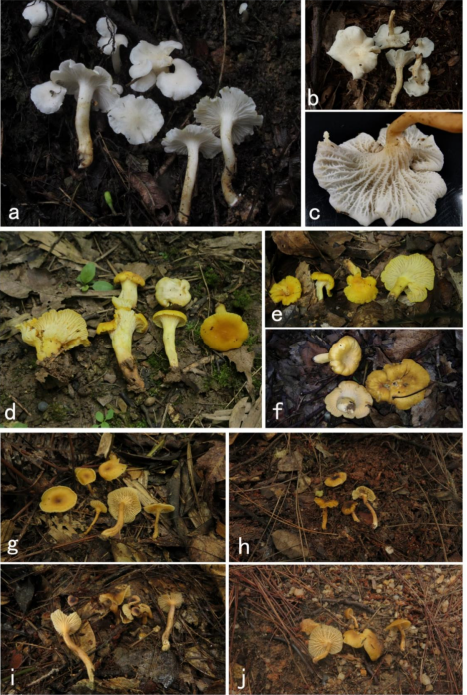 . Species of Cantharellus subg. Parvocantharellus from China. (a–c) C. albus (a) GDGM56646;
(b) GDGM73460; (c) GDGM81399; (d–f) C. aurantinus (d) GDGM46278 holotype (e) GDGM46279; (f)
GDGM81889; (g–j) C. austrosinensis (g) GDGM81249 holotype (h) GDGM80151; (i) GDGM80211; (j)
GDGM80296.
Figure 3. Species of Cantharellus subg. Parvocantharellus from China. (a–c) C. albus (a) GDGM56646;
(b) GDGM73460; (c) GDGM81399; (d–f) C. aurantinus (d) GDGM46278 holotype (e) GDGM46279;
(f) GDGM81889; (g–j) C. austrosinensis (g) GDGM81249 holotype (h) GDGM80151; (i) GDGM80211;
(j) GDGM80296
. Species of Cantharellus subg. Parvocantharellus from China. (a–c) C. albus (a) GDGM56646;
(b) GDGM73460; (c) GDGM81399; (d–f) C. aurantinus (d) GDGM46278 holotype (e) GDGM46279; (f)
GDGM81889; (g–j) C. austrosinensis (g) GDGM81249 holotype (h) GDGM80151; (i) GDGM80211; (j)
GDGM80296.
Figure 3. Species of Cantharellus subg. Parvocantharellus from China. (a–c) C. albus (a) GDGM56646;
(b) GDGM73460; (c) GDGM81399; (d–f) C. aurantinus (d) GDGM46278 holotype (e) GDGM46279;
(f) GDGM81889; (g–j) C. austrosinensis (g) GDGM81249 holotype (h) GDGM80151; (i) GDGM80211;
(j) GDGM80296
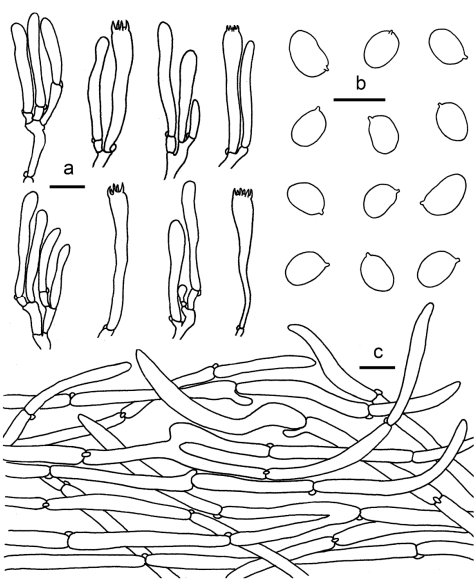
5. Cantharellus aurantinus (GDGM46278, Holotype!). (a) Basidia, basidiola and elements of the
subhymenium. (b) Basidiospores. (c) Pileipellis. Bars: (a,b) = 10 µm; (c) = 20 µm


